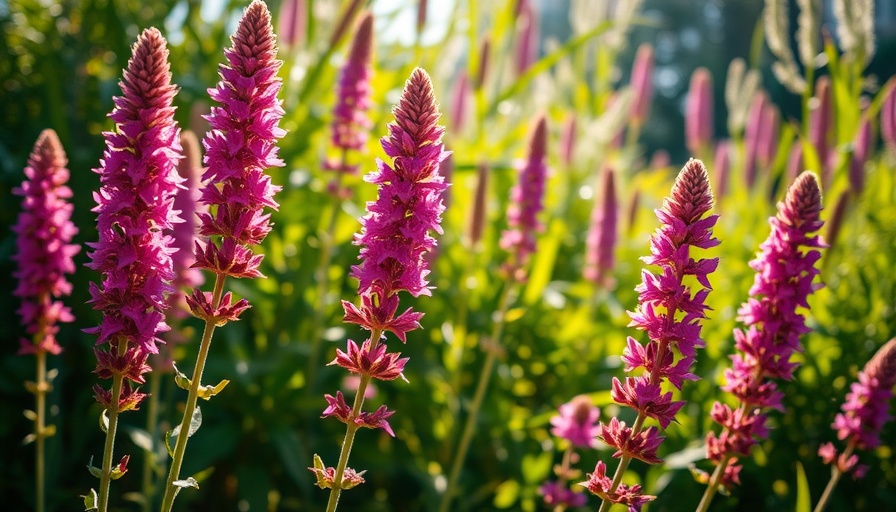
Discover the World of Agastache: Your New Favorite Garden Plant
For gardening enthusiasts looking to create a vibrant and diverse landscape, agastache (Agastache spp.) stands out as a top contender. Known for their stunning colors, delightful fragrances, and wildlife-attracting qualities, these plants neatly fit into an eco-friendly garden plan with their low maintenance and adaptability. As a self-sustaining gardener, you might wonder which types of agastache will best enhance your space and serve multiple purposes—from culinary applications to pollinator support.
What Makes Agastache Special?
Agastache can garner attention not only for its charm but also for its remarkable benefits. These hardy perennials bring color and fragrance to gardens in Zones 4-10 and provide excellent nectar sources for pollinators like bees and butterflies. Furthermore, many varieties, such as Anise Hyssop (Agastache foeniculum), have culinary applications, contributing aromatic flavors to teas and dishes, while also supporting local biodiversity. If you’re striving for a garden that offers both beauty and utility, choosing agastache may just be the smartest gardening hack.
Top Agastache Varieties to Cultivate
Here are 19 exhilarating variants of agastache to consider for your home garden. They span a variety of colors, sizes, and uses:
- Anise Hyssop - Renowned for its licorice-anise flavor and pollinator-friendly blooms.
- Arizona Sun - A petite hybrid with cheerful yellow flowers, perfect for small spaces.
- Blue Boa - A standout with vibrant blue flowers, attracting pollinators and attention alike.
- Blue Fortune - Known for its tall stature and striking flower heads.
- Giant Mexican - Offers a unique addition with its large blooms and vibrant colors.
- Hummingbird Mint - The perfect choice for attracting hummingbirds with its tubular flowers.
- Korean Mint - Great for pest resistance, adding flavor and presence to your garden.
- Kudos Ambrosia - A compact variety with lovely pink flowers.
- Kudos Mandarin - Vibrant orange blooms brighten any garden bed.
- Kudos Silver Blue - Stunning silvery-blue foliage with abundant flowers.
- Kudos Yellow - Bright and cheerful, this agastache brings sunshine to your corner.
- Mountain Hyssop - The alpine variant providing resilience against harsh climates.
- Peachie Keen - Its peach flowers are truly an aesthetic delight.
- Poquito Orange - Small but bursting with citrusy color.
- Purple Haze - A rich, dark hue offering depth to flower beds.
- Rosie Posie - Soft pinks complement blooming neighbors beautifully.
- Royal Raspberry - Deep raspberry colors stand out against green foliage.
- Tango - Adds lively splashes of color throughout the growing season.
- Threadleaf - Unique leaf structure gives it an intriguing appearance.
Creating a Pollinator-Friendly Garden
Integrating agastache into your garden is not only about aesthetics; it’s also about contributing to the health of local ecosystems. Pollinator populations are declining globally, making it crucial to cultivate plants that offer food sources like the hollow nectar-filled flowers of agastache. By planting several varieties together, you can create a vibrant and inviting habitat for bees, butterflies, and other beneficial insects.
Easy Steps to Grow Agastache Successfully
Starting your agastache garden may feel overwhelming, but with a few easy steps, you can usher these beauties into your home:
- Select Your Varieties: Choose agastache based on size, color, and intended use.
- Prepare the Soil: Agastache thrives in well-draining soil enriched with organic matter.
- Plant with Purpose: Space plants appropriately to allow for air circulation and maximum sunlight.
- Water Wisely: Newly planted agastache requires regular watering until established.
- Enjoy Gardening! Once rooted, these low-maintenance plants will provide lasting joy.
How to Use Agastache in Your Kitchen
Not only do agastache plants beautify your outdoor space, but they can also enhance your culinary endeavors. The leaves of species such as Anise Hyssop can be used to infuse flavor in various dishes or brewed into soothing herbal teas. Experiment with agastache leaves in salads or as garnishes to delight family and friends during meals, adding both taste and visual appeal.
Final Thoughts on Agastache for Your Home
Whether you are drawn to their striking floral displays or the myriad benefits they bring to the ecosystem and your kitchen, agastache varieties provide a versatile option for any home gardener. They harmoniously blend beauty with practicality, making them an essential part of your garden education.
Ready to expand your gardening knowledge and get started? Dive deeper into our essential guides and resources for more gardening tips and tricks that will empower you to grow your own food and get the most out of your planting experience. Embrace the joy of gardening today!
 Add Row
Add Row  Add
Add 




 Add Row
Add Row  Add
Add 

Write A Comment